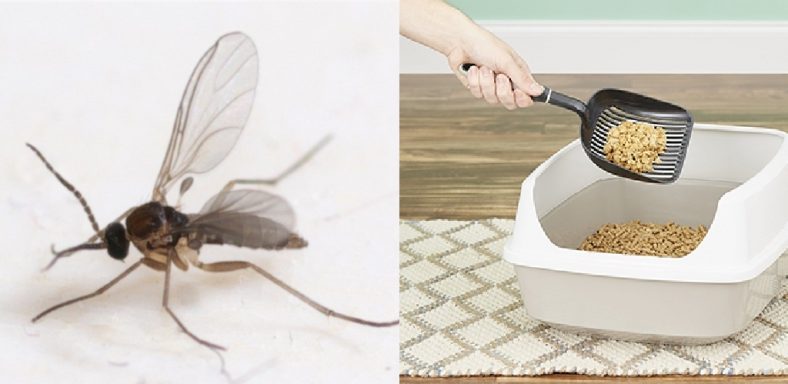Are you having a problem with gnats in your litter box? If so, don’t worry; you’re not alone. This is a common issue and several ways to address it. Gnats are tiny, pesky flies that can be a nuisance both indoors and outdoors. So if you have a litter box, there’s a good chance you’ll also have gnats.
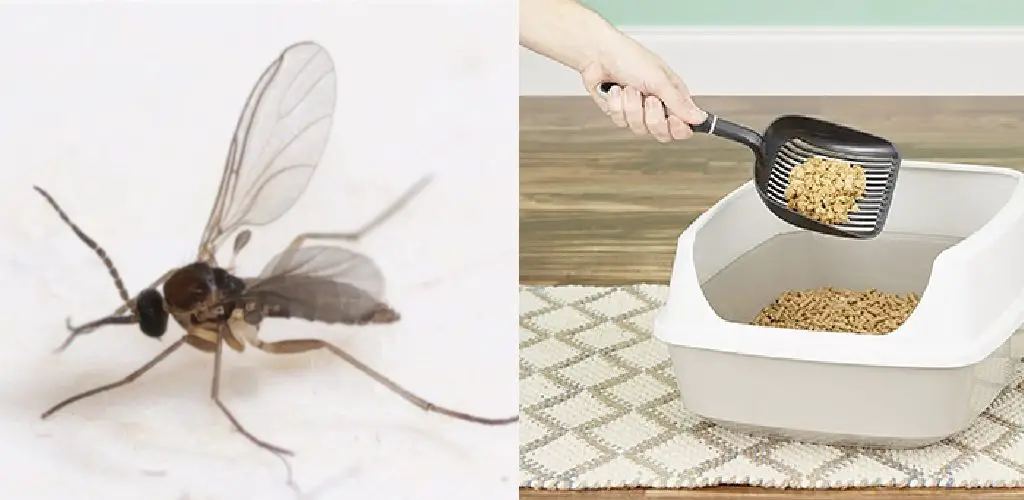
In this article, we’ll explore some of the most effective methods how to get rid of gnats in litter box. We’ll also provide some tips for preventing these insects from becoming a nuisance in the first place. So read on to learn more!
Contents
12 Proven Ways on How to Get Rid of Gnats in Litter Box:
1. Clean The Litter Box Regularly:
Dispose of any feces and unsoiled litter that may be in the box daily. This eliminates the food sources on which gnats thrive. Change your cat’s litter once a week more often if several cats use the same box, and scrub the sides of the box with hot, soapy water to eliminate odor-binding bacteria.
2. Change Your Cat’s Litter:
Cats can be picky about their litter, so changing the brand may reduce the number of flies you have around your home and make your cat more comfortable with its living arrangements. Often, these little creatures are lured by a strong smell and will gravitate toward strong-smelling litter. Therefore, use a mild, unscented brand of litter if possible.
3. Try Some Boric Acid:
Sprinkle boric acid under your cat’s food bowl and on the floor outside her litter box to help battle the infestation. You mustn’t use boric acid inside your cat’s litter box or around her food dish.
4. Use Boiling Water:
Pour boiling water directly into the litter box to scald any larvae lurking there. This can also help reduce the smell of feces left behind by dead adults or larvae. You can also purchase traps that are designed to get rid of gnat infestation.
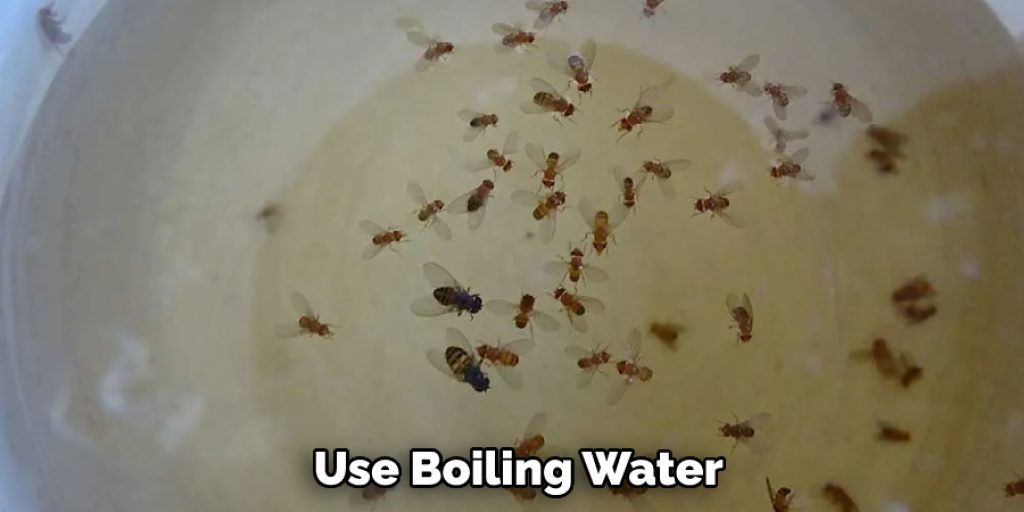
5. Place the Litter Box in a Sunny Place:
Gnats are attracted to areas with moisture, darkness, and foul odors. Positioning your litter box in a more open area where it receives adequate sunlight reduces dampness and will help keep the smell down. Also, place the litter box, so it is not shaded by plants or furniture and keep it away from decaying organic matter such as leaves, mulch, etc.
6. Use Flying Insect Killer:
Use a flying insect killer to help control and kill gnats that may be present in the home. Spray the furniture surfaces and other areas where you’ve noticed gnat activity. Pay particular attention to windowsills and doorways, as these are regular entry points for these insects.
7. Cut Down on Moisture:
Gnats need a source of standing water to lay their eggs and for larvae to develop into adults. Therefore, eliminate any standing water from your environment. Change the water in pet dishes every day and clean them with hot, soapy water before refilling. Keep trash can lids closed tightly, empty trash regularly, and maintain your plumbing by repairing leaks promptly.
8. Use A Good Insecticide:
Although there are many organic methods to get rid of gnats in the cat litter box, some people may prefer using an insecticide to quickly eliminate this infestation and reduce the number of pests around their homes. Read the product label carefully for specific information on its use if you choose to use an insecticide instead of natural remedies for getting rid of gnats in the cat litter box.
9. Try Apple Cider Vinegar:
Mix one apple cider vinegar with two parts water and store the mixture in a spray bottle. Spray this on your cat’s litter box, the floor outside of the box, and around any other areas you have seen adult flies appear. You can also try mixing 1/4 cup apple cider vinegar with 1-quart water in a bucket and placing this mixture into a large spray bottle. Fill smaller spray bottles to use for spot applications.
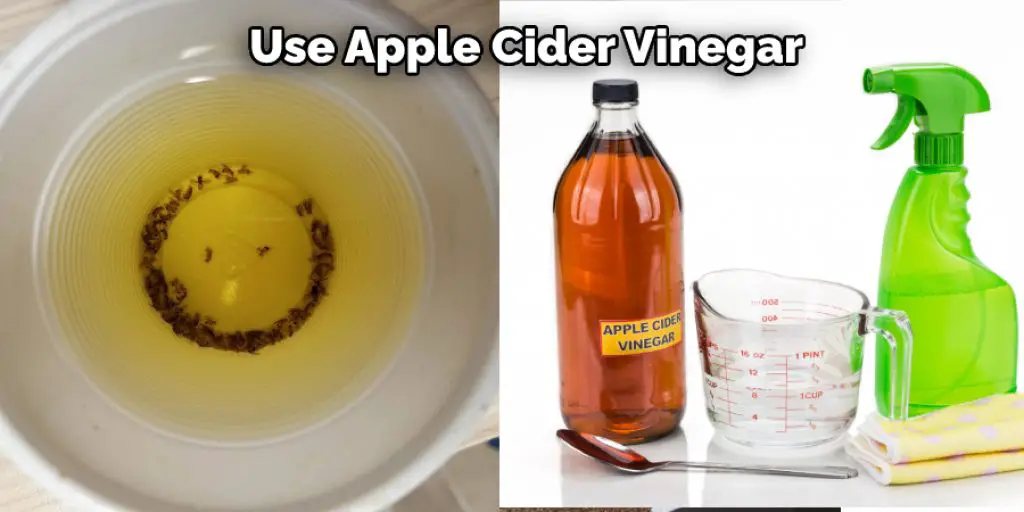
10. Utilize Vinegar with Fungicide:
Add one cup of vinegar to three cups of water with a tablespoon of dishwashing soap and mix well so that it is not too runny. Pour this into a spray bottle and spritz surfaces where you have seen gnats congregating, making sure they are thoroughly wet. Do not use this solution on plants or wood surfaces where grapes will be grown because the vinegar will kill grapes or grapevines when used at full strength or undiluted on their foliage. Let the solution air dry without rinsing; you can
11. Use Diatomaceous Earth:
Diatomaceous earth (DE) is made from fossilized tiny skeletal remains of marine phytoplankton, called diatoms. They look like broken glass under the microscope, which is how it works to get rid of gnats in litter box areas and other pests.
12. Use A Damp Rag:
When cleaning your cat’s litter box, use a wet rag to wipe out the edges of the box to remove any larvae that may have survived the boiling water treatment or other remedies you have tried. Next, spray DE or vinegar around the edges of the litter box and on top of the litter to help keep down any larvae that manage to escape.
Some Tips and Suggestions to Get Rid of Gnats:
Here are some tips on how to get rid of gnats in litter box.
1. Check your kitty’s litter box. Check for any cracks or holes that gnats may use to get into the box to lay their eggs. Also, please make sure there are no plants, magnets, plastic bags, etc. around it, which might give them cover.
2. Clean the area around the box, vacuum all crevices and wipe surfaces with a disinfectant.
3. Locate the areas where gnats congregate and inspect these places to find out how they might reach this area. Check for cracks or holes that need repairs or for plants, magnets, etc, that may have been moved to this location from elsewhere in the house.
4. Change the kitty litter. Preferably use a non-clay-based litter, which is more expensive but dries solid and gives no food or moisture for gnats to feed on or lay eggs in. The hard surface will also facilitate an easier cleanup than the soft clay surfaces.
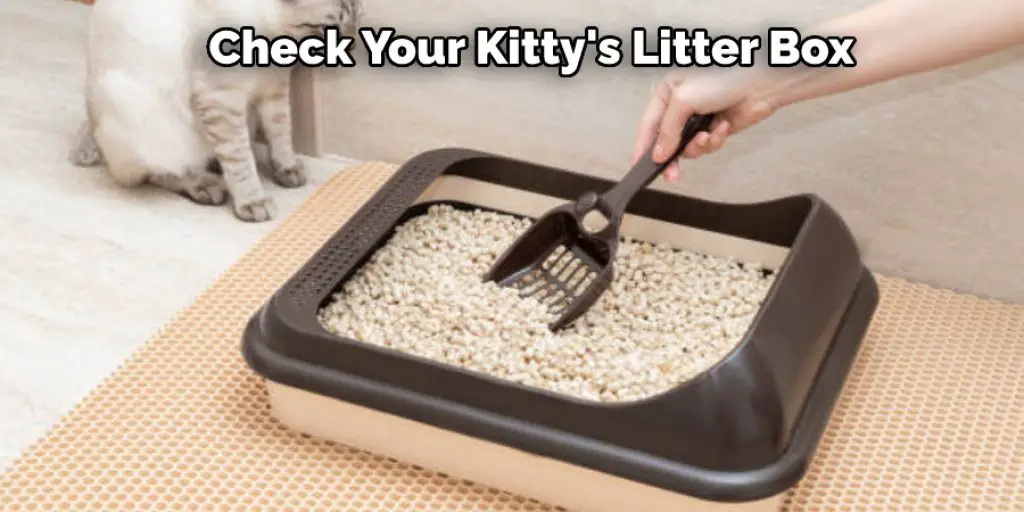
5. Gnats are attracted to moisture and light, so make sure that no standing water is lying around your home.
6. Inspect all plants in your house to ensure they are not infested with gnats or other bugs breeding on them.
7. Use a fan near the potential breeding ground for several hours a day; alternatively, use a container filled with water and dish soap instead of a fan; the gnats will drown themselves in it!
Do Flies Lay Eggs in Cat Litter?
Flies are generally attracted to fresh feces, garbage, and dirt. They lay their eggs in these locations so that the larvae have immediate access to a food supply when they hatch. Flies can also lay their eggs in wet litter boxes. This is not because the flies are looking for cat feces to eat; it has much more to do with the fact that the larvae are looking for a moist environment to develop.
The feces in the litter box provides nutrients necessary for the larvae to survive. While many people believe that flies lay eggs in cat litter boxes because these containers are filled with fecal matter, this is not accurate. The true reason why flies lay their eggs in cat litters has nothing to do with feces or dirt but rather wetness and moisture. The presence of feces does not take away from this fact.
Frequently Asked Questions:
Why Are Gnats Attracted To Litter Boxes?
Gnats are attracted to moist and dark environments such as the litter box. The role of the cat in this situation is mostly that of an innocent bystander. Most gnats or fruit flies do not cause any harm or even pose a risk, but they are still incredibly annoying.
Gnats enjoy moist places to lay their eggs because the hatching larvae require moisture. Therefore, the bottom of a litter box is damp and dark, making it an ideal location for this type of insect to thrive.
How Can I Keep My Cat From Eating Gnats?
If your cat is getting into the habit of eating bugs, you can do a few things to help reduce the problem. First, you need to ensure that your gnat traps are very effective. If they’re not killing enough gnats, none will be attracted to the traps. You may also want to try using a different type of bait or try traps that work by emitting an odor. Some people have had success with this method.
If the problem is not the traps, but your cat still insists on eating bugs around the home, you can try moving gnat-catching stations to places where your cat cannot get to them. You may also want to try using a different type of bait, such as tuna juice or something else. However, if your cat is determined to eat the bugs and can’t seem to stop them, you may want to consider keeping it indoors.
Conclusion
If you have a cat, there’s a good chance you’ve dealt with gnats in the litter box at some point. Unfortunately, these pesky little bugs can be challenging to get rid of and make your life miserable. In this article, we have discussed what gnats are, how they reproduce, and some methods for getting rid of them.
We’ll also have provided some helpful tips on preventing them from returning. We hope this blog post on how to get rid of gnats in litter boxes has been helpful. If you have any questions or want to know more, then feel free to comment below!

